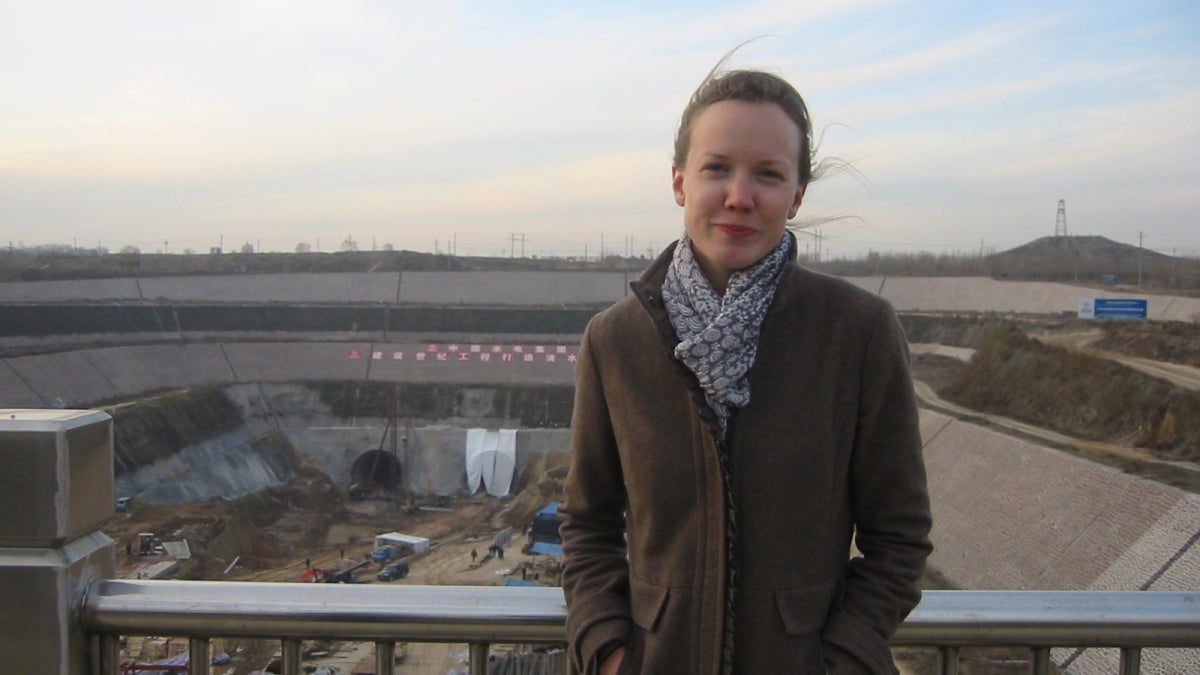China’s water infrastructure, food-energy-water nexus subject of ASU professor's research

Britt Crow-Miller, assistant professor at the School for the Future of Innovation in Society, during a visit to the South to North Water Transfer Project in China during its construction.
The Social Science Research Council’s InterAsia Program recently selected Britt Crow-Miller as an SSRC Transregional Research Junior Scholar fellow for the 2017-2018 year. Crow-Miller is an assistant professor in Arizona State University's School for the Future of Innovation in Society and a senior sustainability scientist with the Julie Ann Wrigley Global Institute of Sustainability.
Crow-Miller’s SSRC proposal, "The Emerging Geography of Chinese Water Infrastructure: InterAsian and Transregional Connections in the Food-Energy-Water Nexus," was one of only 14 selected for the award from more than 150 eligible initial proposals and 37 finalists.
Collectively, her cohort represents five countries, multiple academic disciplines, and 10 different universities. The fellowship supports projects that re-conceptualize research on Asia, especially work that pushes the boundaries of current frameworks for transregional and transnational research.
“I’m excited to be connected with the SSRC,” Crow-Miller said. “The fellowship’s focus on transregional research has allowed me to enter a new space and think about China’s water infrastructure issues in a way that I might not have considered otherwise.”
That new space is the food-energy-water nexus, a holistic framework that allows researchers to consider how all three domains interact, and to manage resource use, trade-offs and synergies within a given system. The nexus is new to Crow-Miller.
“I’ve been thinking about the water-energy-food nexus for a few years now, and the fellowship call triggered a lightbulb,” she said. “China’s water projects are creating new connections across sectors and regions, and right now we just don’t have a good framework for taking that complexity into account.”
Crow-Miller’s research sits at the intersection of politics, environment, development and technology — with a focus on China’s water infrastructure, which she says is part of a fundamentally unsustainable model of water management governed by a mix of corporations, bureaus, universities and government ministries that she and her colleagues have dubbed the “China Water Machine.”
“By taking a critical inventory of the InterAsian and transregional nexus interconnections of Chinese water infrastructure, I expect a complex web of connections to begin to emerge,” she noted in her project proposal.
The huge and still growing Chinese population, along with rapid urbanization and industrialization, has motivated the government to implement massive projects to meet its domestic need.
China’s traditional reliance on “hard path” solutions — characterized by delivery of more water rather than more sustainable use of what is already available — and big, concrete infrastructure projects significantly affect neighboring nations and entire regions that do not share a border with China.
China’s tens of thousands of dams and water-transfer projects — including the world’s largest, the South to North Water Transfer Project — affect flow for everyone downstream.
“China is such a political powerhouse in the region, at this point there’s nothing to really compel them to take downstream interests into serious consideration,” Crow-Miller said.
Meanwhile, China leverages economic and political resources to encourage or coerce nations outside of its region — mainly in South America and Africa — to implement water infrastructure projects similar to its own.
“China has built up the capacity and expertise to implement these water projects at massive scales, but they can only build so many domestically,” she said. “They want to export that expertise for profit.”
Crow-Miller’s interest in China began to emerge when she participated in a study-abroad trip to China in high school. She studied Chinese history and environmental history in college. For her master’s degree, she studied environmental protest movements in modern China before earning her doctorate in geography, where she studied water, development, political geography and political ecology.
In addition to her work in the East, she has also worked on a number of sustainable urban water management projects in cities of the American West. Her background in history gives her a unique perspective that has proven useful in her new faculty position alongside SFIS’s future-focused mission.
“We have to understand where we come from,” she said. “The water management decisions of the past become the inheritance that informs and often constrains the decisions of water managers in the future. Unfortunately, that insight isn’t always part of the conversation, especially in developing countries focused on shorter-term economic growth goals.”
One important output from her research will be a new sustainability index that will be capable of improving outcomes associated with both existing and planned water infrastructure projects.
She hopes her research will encourage decision-makers in water management positions and citizens affected by such projects to foresee how water infrastructure involves impacts beyond water — and beyond their immediate physical proximity.
“When the topic of sustainable development comes up, everyone talks about social, ecological and economic perspectives, but no one has taken a serious look at how those three dimensions interact across sectors, borders and regions when it comes to water infrastructure,” she said. “The index is the end goal of the project and will likely take several years, but when it’s completed I hope it will give us a better picture of what the trade-offs really are by looking at projects all over the world through a more holistic lens.”
Written by Denise Kronsteiner and Adam Gabriele
More Science and technology

ASU and Deca Technologies selected to lead $100M SHIELD USA project to strengthen U.S. semiconductor packaging capabilities
The National Institute of Standards and Technology — part of the U.S. Department of Commerce — announced today that it plans to…

From food crops to cancer clinics: Lessons in extermination resistance
Just as crop-devouring insects evolve to resist pesticides, cancer cells can increase their lethality by developing resistance to…

ASU professor wins NIH Director’s New Innovator Award for research linking gene function to brain structure
Life experiences alter us in many ways, including how we act and our mental and physical health. What we go through can even…